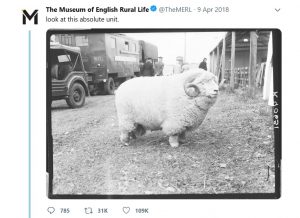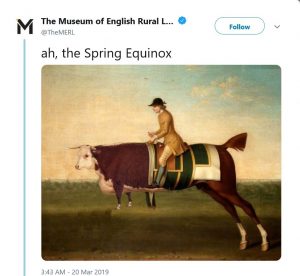by Gaia Cloutier

On April 9, 2018 the Museum of English Rural Life (@TheMERL) tweeted an image of an extremely fat and woolly Exmoor Horn ram, captioning the image “look at this absolute unit.” The Internet went wild. The tweet currently has more than 109K likes, 31K retweets, and 750 comments and was featured in a Twitter Moment, Buzzfeed, the BBC, Mashable, and The Times. Looking at the tweet, it is not a surprise that the internet loved it. The internet loves few things more than memes and pictures of cute animals, and the MERL tweet has both. The MERL’s ability to capitalize on this single viral tweet, however, is just as impressive as the glorious ram itself.
The MERL is a University of Reading run museum, library, and archive dedicated to the history and culture of farmers, craftspeople, and other people living in rural England. The MERL has over 25,000 museum objects, 50,000 books, 1 million photographs, hundreds of hours of film, and 4.5 kilometers of archival holdings. In addition to its services and events for scholars and affiliates of the University of Reading, the MERL also engages with local farmers and craftspeople, families, and other members of the greater Reading community. Historically, however, the Museum was not reaching as diverse an audience as it would like and their digital engagement was not very effective. This was especially a problem when it came to engaging young people with the collections.
With the success of the ram, however, the MERL saw a new way forward with digital engagement. Led by Adam Koszary, the programme manager and digital lead who wrote the absolute unit tweet, the MERL has completely revamped its approach to Twitter. The central philosophy of this new approach is to have fun and to embrace the social aspect of Twitter. Twitter is not just another forum for posting exhibit copy, catalog metadata, or marketing material. It is an opportunity to think creatively about the Museum’s collections and to engage with people directly. The original ram tweet was a funny picture and a fun use of a meme. But the engagement that happened after that tweet is what helped the MERL become a Twitter sensation. Koszary joked with followers, posted more images of livestock, tweeted about the history of the image in the tweet, answered questions, made a poll, and generally treated responses to the tweet as an opportunity to have a conversation.
The account’s more recent moments of Twitter fame, like a duck pic battle with other museums and the saga of Merlin the bat, have built upon this model: tweet an image, usually of an animal, tell a fun or interesting story about the image, have a generally humorous approach, and keep the conversation going past the original tweet by directly engaging with people’s responses. It is a simple formula, but it only works because it is authentic to the Museum and its mission. The MERL is a museum about rural life, so animals are a major subject of their collection. Unlike corporations coopting memes to sell hamburgers or shoes, the MERL uses them in a spirit of fun and genuine social engagement. This authenticity keeps the account fresh, fun, and relevant.
The MERL’s new approach to Twitter has exponentially increased the Museum’s digital engagement. The account’s followers jumped from 9.7K to 118K in the past year. 40K people visited the MERL website in April of 2018 alone. These numbers indicate a massive increase in engagement with digital projects like the website’s blog, digital collections, and digital exhibits. It also means that more people are seeing the Museum’s tweets about events and resources at the physical building. Whether or not this increase in digital engagement translates into an increase in visitors to the physical Museum remains to be seen. Meanwhile, the MERL’s Twitter account will continue to be a place where the Internet can gather to enjoy animals, memes, and whatever is going on here:

More information about the MERL’s digital engagement can be found in Adam Koszary’s report on the viral tweet as well as on his blog.
